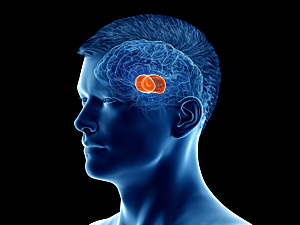A recently developed treatment for severe, medication-refractory essential tremor (ET) is MRI-guided focused ultrasound (MRgFUS) thalamotomy. This transcranial, incisionless technique incorporates real-time thermometry and submillimeter adjustments based on patient feedback before ablation.
Investigators at Brigham and Women’s Hospital helped lead a multicenter, randomized, double-blind, sham-controlled trial of unilateral MRgFUS thalamotomy performed with the Exablate 4000 system (InSightec, Miami, FL). The initial report in the New England Journal of Medicine of significant improvement informed the FDA approval of the device. Later, the researchers published reassuring three-year results in Neurology.
Now, in the Journal of Neurosurgery, team members have published five-year data on the same cohort that demonstrate the long-term safety and efficacy of the procedure. The authors are G. Rees Cosgrove, MD, director of the Epilepsy and Functional Neurosurgery Service, Michael Hayes, MD, chief of the South Shore Hospital Neurology Service, Nathan McDannold, PhD, research director of the Focused Ultrasound Laboratory in the Department of Radiology, and colleagues.
Efficacy
Of the 75 patients with medication-refractory ET and significant disability who underwent unilateral MRgFUS thalamotomy in the trial, 40 completed the five-year follow-up. At that timepoint the researchers noted sustained significant improvements in tremor severity, functional disability, and quality of life:
- Mean tremor severity score (postural component of the Clinical Rating Scale for Tremor [CRST], Part A, for the treated side)—mean change of 73% from baseline to five years (P<0.0001)
- Mean composite tremor/motor score (CRST Parts A and B), the primary endpoint of the trial—mean change of 40% (P<0.0001)
- Mean disability score (CRST Part C)—mean change of 44.5% (P<0.0001)
- Quality of Life in Essential Tremor Questionnaire (QUEST)—At five years, significant reductions from baseline persisted in total score and subscores for the physical, psychological, and work and finance dimensions; improvement on the hobbies and leisure dimension was not significant at five years and throughout follow-up, there was little improvement in the communications dimension
Safety
No new adverse events (AEs) related to or probably related to the procedure were reported from the one-year timepoint to the last follow-up. All persistent AEs remained mild or moderate. The remaining AEs included paresthesia (n=8 patients), imbalance (n=6), unsteadiness (n=2), gait disturbances (n=2), limb weakness (n=2), dysmetria (n=2), dysgeusia (n=2), slow movements (n=1) and head pressure (n=1).
An Alternative to Deep Brain Stimulation
The five-year efficacy of MRgFUS thalamotomy in this study is comparable in magnitude to that observed five years after unilateral deep brain stimulation (DBS). The safety profile is also similar, or no worse.
Patients with significant medical illness, elderly patients, and patients unwilling to have an invasive neurosurgical procedure can consider MRgFUS thalamotomy as an appropriate alternative. Interestingly, although the uptake of MRgFUS continues to rise, there has been no apparent reduction in DBS procedures for ET, suggesting MRgFUS is an appealing option for an underserved population.
